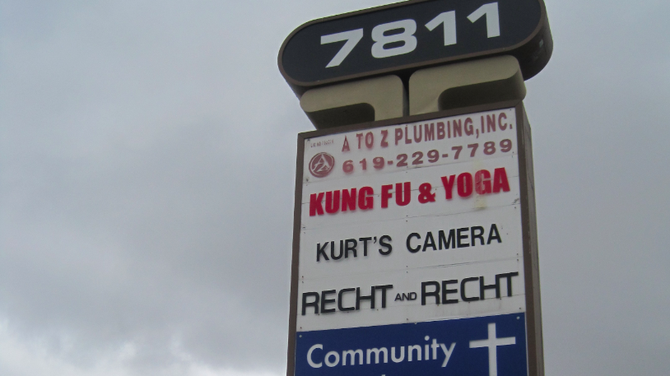 Facebook
Facebook
 X
X
 Instagram
Instagram
 TikTok
TikTok
 Youtube
Youtube

The Navajo Community Planners, Inc. (NCPI), on April 15 voted 13-3 to support H.M. Coleman Inc.'s request to "initiate" a community-plan amendment to change the designation of a 4.5-acre triangular site at 7811 Mission Gorge Road from commercial use to multi-family medium residential density.
That classification allows for 15 to 29 dwelling units per acre, and housing is planned on four acres, Randi Coopersmith of Latitude 33 Planning & Engineering told the community planners group. The panel makes planning recommendations for the neighborhoods of Allied Gardens, San Carlos, Grantville, and Del Cerro.
The NCPI vote supported initiation of the process that included a March 25 San Diego Planning Commission hearing on H.M. Coleman, Inc.'s request for the plan amendment.
Tenants at the site include Kurt's Camera, the Community Church of San Diego, and Macintosh Doctor. The church was not mentioned in the letter to the planning commission that Coopersmith wrote on behalf of his client. In that letter, he wrote that existing uses included "non-essential goods and services." He wrote that the center has “struggled with vacancies for many years due to the sites [sic] aging structures and poor retail location with limited access." That was among the reasons that the location "is logical for multifamily" use, Coopersmith wrote.
Prior to the NCPI vote, board member Matt Adams said, "I lived here almost 30 years; I don't think I've been in that" center. Board member Sherry Kelly said "a good convenience store could pull in business.” Coopersmith spoke about traffic generated by commercial use, particularly businesses open 24 hours.
San Carlos Area Council president John Pilch said that the council board saw a Latitude 33 presentation on April 3 and voted 6-0 against initiation. "Whatever is in there is going to have problems. We feel something should be done to the center [such as] an upgrade to attract tenants," he said.
Resident Janie Klein voiced concerns about traffic. "I did the math," she said. With 120 units and two cars for each home, that's "240 cars." Coopersmith responded that Klein's calculation was based on the maximum number of units and that a successful commercial site would produce more traffic.
NCPI member Marilyn Reed asked Coopersmith how close proposed residences would be to existing homes. That wasn't yet known, he said. "We have to get an initiation." He said that the public process would start with public notices.
Terry Cords of the NCPI said that he while he understood rezoning, he wanted "two to three options" for the site. Coopersmith said issues like that came up after the initiation was approved and the process started.
Cords, Reed, and Kelly voted against the NCPI motion to support initiation. After the vote, NCPI chair Anthony Wagner spoke about the use of developer impact fees for projects such as median landscaping.
"We're not supporting 10,000 units to go 60 feet high,” said Wagner. “We're supporting a feasibility study. Let's see what we [can] get for our community."


The Navajo Community Planners, Inc. (NCPI), on April 15 voted 13-3 to support H.M. Coleman Inc.'s request to "initiate" a community-plan amendment to change the designation of a 4.5-acre triangular site at 7811 Mission Gorge Road from commercial use to multi-family medium residential density.
That classification allows for 15 to 29 dwelling units per acre, and housing is planned on four acres, Randi Coopersmith of Latitude 33 Planning & Engineering told the community planners group. The panel makes planning recommendations for the neighborhoods of Allied Gardens, San Carlos, Grantville, and Del Cerro.
The NCPI vote supported initiation of the process that included a March 25 San Diego Planning Commission hearing on H.M. Coleman, Inc.'s request for the plan amendment.
Tenants at the site include Kurt's Camera, the Community Church of San Diego, and Macintosh Doctor. The church was not mentioned in the letter to the planning commission that Coopersmith wrote on behalf of his client. In that letter, he wrote that existing uses included "non-essential goods and services." He wrote that the center has “struggled with vacancies for many years due to the sites [sic] aging structures and poor retail location with limited access." That was among the reasons that the location "is logical for multifamily" use, Coopersmith wrote.
Prior to the NCPI vote, board member Matt Adams said, "I lived here almost 30 years; I don't think I've been in that" center. Board member Sherry Kelly said "a good convenience store could pull in business.” Coopersmith spoke about traffic generated by commercial use, particularly businesses open 24 hours.
San Carlos Area Council president John Pilch said that the council board saw a Latitude 33 presentation on April 3 and voted 6-0 against initiation. "Whatever is in there is going to have problems. We feel something should be done to the center [such as] an upgrade to attract tenants," he said.
Resident Janie Klein voiced concerns about traffic. "I did the math," she said. With 120 units and two cars for each home, that's "240 cars." Coopersmith responded that Klein's calculation was based on the maximum number of units and that a successful commercial site would produce more traffic.
NCPI member Marilyn Reed asked Coopersmith how close proposed residences would be to existing homes. That wasn't yet known, he said. "We have to get an initiation." He said that the public process would start with public notices.
Terry Cords of the NCPI said that he while he understood rezoning, he wanted "two to three options" for the site. Coopersmith said issues like that came up after the initiation was approved and the process started.
Cords, Reed, and Kelly voted against the NCPI motion to support initiation. After the vote, NCPI chair Anthony Wagner spoke about the use of developer impact fees for projects such as median landscaping.
"We're not supporting 10,000 units to go 60 feet high,” said Wagner. “We're supporting a feasibility study. Let's see what we [can] get for our community."
Comments